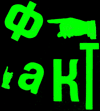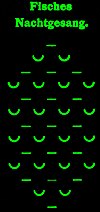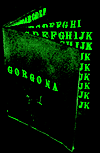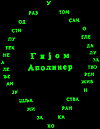Vuk
Cosic
3D ASCII, An Autobiography
#0 Works and experiments with moving ASCII , ASCII audio, ASCII camera
and such, are all directed towards conversions of contents between one
media platform and an other, every time carefully directed at their full
uselessness from the viewpoint of everyday high tech and all it's consequences.
The ambition to basically convert the whole world into ASCII contains
few conceptual and possibly theoretical premises that are subject of this
text based communication unit.
The idea to develop a three dimensional ASCII environment is deriving
from the evolution of my other ASCII works presented in various web sites
as well as in numerous shows and festivals, but I would like to present
the 3D ASCII project also in the light of several art disciplines that
are tangentially linked to such an endevour. These typically art related
considerations are accompanied also by a number of non-artistic disciplines
or lines of thought.
Classical text based art forms
 For
all my life I have been attracted to unorthodox creation and usage of
writing. Every attempt to explore the space beyond text in lines, or between
two pages in the same leaf, or between the letter and the paper that hold's
it was much more meaningfull then the most skillfully described night
dress in french nineteenth century novel or then an existential crisis
in the soul of a more recent literary hero.
For
all my life I have been attracted to unorthodox creation and usage of
writing. Every attempt to explore the space beyond text in lines, or between
two pages in the same leaf, or between the letter and the paper that hold's
it was much more meaningfull then the most skillfully described night
dress in french nineteenth century novel or then an existential crisis
in the soul of a more recent literary hero.
#1 I remember while reading any prose how the spaces between words used to create landscapes with meandering rivers and naked trees. Later when I met the writings of Italo Calvino where he spoke of reading of landscapes as if they were text I saw good symmetry between these two thoughts.
#2 It's been quite some time that I am seroiusly interested in what the OuLiPo guys have been doing in the sixties and seventies (although there's quite some movement even nowadays) - thoughts of text based art deriving from such a radical formal analysis seemed at first, and still does, like an utterly useless idea, thus wonderfull. The works of Quenneau and - even more - Perec have taught me to look at text in one more way.
 #3
Malarme, Apollinaire, Dada, Surrealism, Pataphisique, OuLiPo, Situ; El
Lisicki, Zdanevich, Hlebnikov, Harms; Gorgona, Mangelos, Martek…
#3
Malarme, Apollinaire, Dada, Surrealism, Pataphisique, OuLiPo, Situ; El
Lisicki, Zdanevich, Hlebnikov, Harms; Gorgona, Mangelos, Martek…
#4 As for three-dimensionality of text, I would say that Chatwins songlines are very important. Crafts and sciences related to writing
#5 History of writing sistems offer grand inspiration. The simillarity of the clay tablet to the computer monitor pushes the mind towards seroiusly amuzing thouhgts. Advent of movable type induces even wilder ideas. IBM golf alphabet balls do the same.
#6 One very important source of amazement is the history of Cryptography. Aestehetically and methodologically, literature as we know it is eons behind achievements of black chambers cipher alchemists from times long forgotten. Creativity and motivation of the makers and breakers of code remains unparalleled for their understanding of quantitative linguistics and psychology of perception.
#7 Typography and issues of general graphic design are inseparable from the ambition to convey meaning with text. At the level of a single sign, writing IS a painting, a very well thought-of graphic leaning on millenia of work. This has to be respected.
History of Technology related Art lead by ASCII
#8 ASCII (American Standard Code for Information Interchange) was indtroduced in 1963 and a historiographic research currently on the way (mostly by Tom Jennings) will give us a full account on it's evolution that will further enable the quest for very first ASCII art. Nevertheless, it is known that before the advent of this standard there was a history of usage of text based terminals for generating graphic-like arangements. John Foust at the web site of his Jefferson Computer Museum is not only offering insight in this long marginalized form, but also mentions so-called RTTY art dating back to 1923. These teletype graphics were mostly used for christmass cards and were done in the way simillar to the ASCII graphics of the sixties. Hopefully it will shortly be possible to announce the publication date of the whole set of research papers covering this topic.
 #9
Other than looking for the eariliest recorded appereance of ASCII art,
it seams important to document all of it's variants in the long decades
of it's existence. Thousands of hard discs around the world contain millions
of ascii drawings, done by more or less anonimous ascii artists, and clearly
one of the tasks is to create a comprehensive history of ascii art. In
my view, most of what this historical overview will produce is classifyable
under Naļve ASCII Art, and very few works will be accepted as anything
more than that.
#9
Other than looking for the eariliest recorded appereance of ASCII art,
it seams important to document all of it's variants in the long decades
of it's existence. Thousands of hard discs around the world contain millions
of ascii drawings, done by more or less anonimous ascii artists, and clearly
one of the tasks is to create a comprehensive history of ascii art. In
my view, most of what this historical overview will produce is classifyable
under Naļve ASCII Art, and very few works will be accepted as anything
more than that.
#10 History of computer aided visual arts is still in the writing by many scollars, and first texts are long existing. While the majority of the works known to me are using the computer to create beautifull and sublime objects, I prefere the ones that sistematically try to investigate the creative potential of the tool itself. Computer art is too often just a promotion for specific equipment, but when it's clever it's the cleverest thing around.
#11 Aesthetics of early computer displays remains a field I would like to know much better. The cathode ray tubes from the fifties and sixties were allmost exclusively used by the military and were all extremely massive which makes them virtually unfindable. The books that give a glimpse into the early monitors are exciting and the images and diagrams tell us of truly fantastic designs of hardware and possibilities for displaying the text and images. Oh, I would love to see an image of ascii art on a monitor older than I am.
Grand unifying theory stuff
#12 There is such a view of the history of civilisation where the move from strictly visual culture to writing introduced a tectonic shift in the way the humans think. On the other hand, the story goes, we are living in the epoch of visual culture (again). Either way it is, I like to see the 3d ASCII as an unexpected psychological event on an individual scale of the viewer through the perception of a space that is text but doesn't lend itself to reading and is actually conveying spatial information. I hope that the mixture of expectancies and perception will lead to interesting and productive confusion.
 #13
The choice of ASCII in previous works as well as in this one is closely
tied to more ideological issues. It is often the case that the artist
is forced to produce creative output with the sole function to justify
some art center's hardware investment. By using given technologies one
is also accepting the creativity limits of the technology maker, maybe,
and I like to believe that my creativity is possibly elsewhere than the
one of the engeneer's, however much respect I express for the makers of
tools. My reaction to this is to look in the past and continue the upgrade
of some marginalized or forgotten technology. Gebhard Sengmüller calles
this archaeology of media.
#13
The choice of ASCII in previous works as well as in this one is closely
tied to more ideological issues. It is often the case that the artist
is forced to produce creative output with the sole function to justify
some art center's hardware investment. By using given technologies one
is also accepting the creativity limits of the technology maker, maybe,
and I like to believe that my creativity is possibly elsewhere than the
one of the engeneer's, however much respect I express for the makers of
tools. My reaction to this is to look in the past and continue the upgrade
of some marginalized or forgotten technology. Gebhard Sengmüller calles
this archaeology of media.
The ASCII Unreal
#14 the piece is dedicated to Mr. Danilo ˇ. Markovic, former serbian ministre of culture who once declared »we all know that cyrillics is not only the most beautifull script but also most suitable for work with computers«.
 #15
the piece has something to do with the fact that it's premiered in Vienna
where serbian cyrillics was first printed, by a man called Vuk.
#15
the piece has something to do with the fact that it's premiered in Vienna
where serbian cyrillics was first printed, by a man called Vuk.
#16 the piece is linked to the work of the Association Apsolutno whose project in Vienna was to trace cyrillic letters in the urban raster of the city.
#17 the piece contains a methodological link to the famous »Disparition« (eng. »Void«) by Perec, in the sense that the hero also dissapears from the fabula after approaching the object of search. Neadless to say that the whole Unreal world is in shape of the letter that doesn't appear nowhere in it's textures or forms.
#18 The plan is to go on with this project, and to finally create an ASCII CAVE where all my literary and technology heroes will meet.